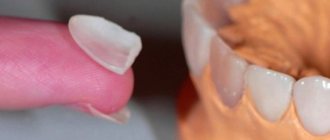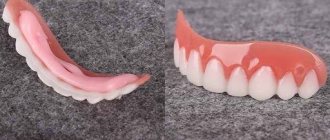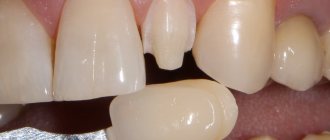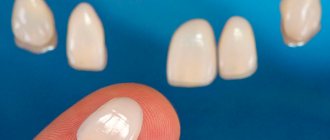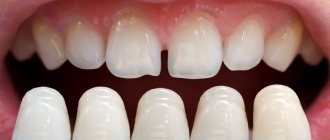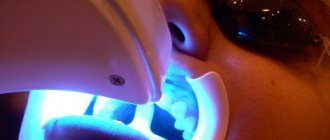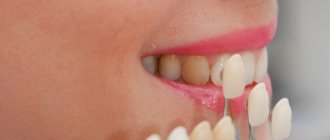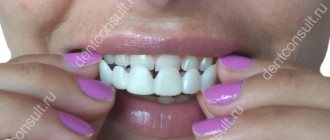- 15937
- 09-10-2020
- Author: Mysekret Team
- 0
Dreams of a Hollywood smile, perfect straight and white teeth without the intervention of dentists and exhausting procedures have become a reality. Perfect Smile Veneers is an innovative development that allows you to realize these desires at home without the use of dental onlays.
What are Perfect Smile Veneers?
Perfect Smile Veneers are universal overlay veneers designed specifically for quick and easy use at home. Veneers are presented in two parts: an overlay on the gums and on the teeth, for the upper and lower jaw.
Every part of the Perfect Smile Veneers is made from durable, hypoallergenic materials.
See also...
✅ What things are “absolutely forbidden” for fat girls to wear?
✅ We teach children to brush their teeth. Frequently asked questions and honest answers
✅ Black bread hair masks
✅ Masks for fast hair growth: 10 folk recipes
The gum pad is made of silicone and imitates the natural structure of the soft tissue of the gums. It provides a secure fit, is pleasant to the touch and comfortable to wear.
The dental guard is made of flexible plastic - a combination of nylon and medical-grade polypropylene. This part is particularly resistant to natural dyes and temperature, and, despite its thinness, is resistant to external influences. The plate fits tightly to the teeth without causing discomfort.
Installation Cons
Despite all the advantages, this restoration method also has some disadvantages.
- The main disadvantage is that installation requires preliminary grinding of the teeth . Accordingly, they will never have the same shape and will have to be worn constantly.
- Among the disadvantages, we can highlight some features of the materials from which they are made. For example, porcelain onlays are too fragile, and composite ones can change color.
Get professional advice on installing high-quality and attractive veneers from us. Elena Plus dentists will do everything to ensure that the veneers serve you for as long as possible.
Who needs veneers?
Perfect Smile veneers help hide a lot of dental problems in the shortest possible time. Their use is especially important on the eve of important events and in cases where a visit to the dentist to correct teeth is not possible.
Perfect Smile Veneers allow you to disguise the following dental imperfections:
- Chips;
- Crevices;
- Lack of teeth;
- Caries;
- Yellowness of enamel;
- Irregularities;
- Darkened fillings;
- Irregular shape;
- Small size.
Perfect Smile Veneers are suitable for use by both men and women, ensuring the creation of an ideal dentition.
The use of veneers is safe and does not affect the natural structure of the teeth and gums. Perfect Smile Veneers are also durable and reusable. When properly used and stored, they can last from a couple of years to ten.
Indications and contraindications
Your doctor may recommend this option if:
- the top and/or bottom row is uneven;
- the enamel has darkened and/or cracked;
- irregularly shaped incisors;
- There are gaps between the teeth.
But the defects should still be minor.
The orthodontist will have to refuse the procedure if:
- most of the problem surface is sealed and/or destroyed;
- there is an incorrect bite;
- there is abrasion (starting from the second degree);
- have gum disease;
- the patient suffers from bruxism.
Each situation is considered individually.
How to put on Perfect Smile pads correctly?
Having purchased a new product, first of all you need to read the instructions on how to install Perfect Smile veneers. It is extremely important to follow clear instructions to avoid improper placement of the overlays on your teeth and gums, as well as any discomfort.
Instructions for use of Perfect Smile Veneers:
- Preparation - place the plates in a glass of hot water for several minutes until the white coating becomes transparent;
- Shaping - we firmly press the veneers to the natural teeth to obtain the required outline of the plate;
- Hardening - immerse the veneers in cold water for a few minutes until the white coating reappears;
- Installation - we put on the plates like ordinary plug-in elements.
The versatility of Perfect Smile Veneers lies in the ability to shape the onlays identical to natural teeth.
Only with proper preparation will Perfect Smile veneers last a long time, will not cause inconvenience and wear well: they do not fall out and do not interfere with talking or eating.
Many buyers complain about the poor quality of the product, not knowing how to use veneers correctly. Therefore, we recommend watching a video on how to put on Perfect Smile Veneers:
https://www.youtube.com/watch?v=1XxFwsLk1Cc
The importance of following recommendations for installation and operation of overlays is sometimes underestimated. The quality of your future smile depends on the correct preparation and placement of the plates. Placing veneers according to the rules allows you to avoid possible difficulties and save time before an important event.
How veneers are installed indirectly
All orthopedic structures in dentistry are made individually, taking into account the structural features of the jaw, the location of the teeth, etc. every patient. Since there are no universal onlays that would suit everyone, the process of making and installing veneers using the indirect method can take two or more weeks. Veneers are generally placed in six stages:
- Primary examination and diagnosis.
- Approval of the treatment plan.
- Fitting and adjustment of the layout.
- Preparation (turning).
- Manufacturing and fitting of veneers.
- Installation and fixation.
Each stage requires an individual approach, and the methodology itself requires the use of unique elements that are suitable only for a specific person. To understand how veneers are placed, it makes sense to take a closer look at the manipulations at each stage.
You might be interested in:
Veneers
Composite veneers
Ceramic veneers
E-max veneers
Artistic restoration of teeth
Initial examination and diagnosis
Occurs during the first visit to the clinic for the purpose of further installation of veneers. At this stage, the following must happen:
- Oral examination
. In order to determine the scale of the problem and the level of tooth decay that requires restoration. At the same time, possible preliminary procedures are determined (for example, cleaning tartar, eliminating caries, etc.). Based on the general condition, an anamnesis is collected. - Confirmation of indications and verification of the absence of contraindications
. Veneers, as an option for artistic restoration, are not indicated for all dental defects. After examining the oral cavity, the dentist accurately determines whether veneers are suitable for solving the problem or whether other types of restoration should be preferred. In addition, the doctor must find out whether there are any contraindications. - Collection of analyzes
. Depending on the situation, this may include referrals for an X-ray or CT scan. The data obtained will allow the specialist to determine the condition of the bone tissue as accurately as possible and identify possible pathologies in order to prevent and/or prevent complications after the procedure. - Study of facial anatomy
. The dentist carefully examines the face as a whole, as well as specifically the mouth and lips and their relationship to the teeth. Very often at this stage photographs of the oral cavity are taken - the pictures will be used to draw up an individual treatment plan. - Discussion of the desired result
. Since beauty is a purely subjective concept, it is necessary to determine what aesthetic effect is expected by the patient. This is especially important in cases where overlays are needed not for 1-2 teeth, but for the entire smile area. Right now the desired shade and other cosmetic nuances are being discussed. - Scanning and impressions
. Depending on the situation, for further production of individual onlays, silicone impressions are made or, using an intraoral scanner, digital scanning is carried out. The data obtained is necessary in order to create a diagnostic model as accurately as possible and study the characteristics of the bite in detail. This data will also be used in the future for digital computer modeling.
When planning to install orthopedic structures, as an example and visual aids, you can provide photos of smiles that you like, asking to achieve the same result. If in doubt, you can always consult your doctor, who can give professional advice and offer the best options for the shade of veneers and other technical nuances.
Treatment plan approval
After collecting information during the initial examination, the specialist you contacted, in order to obtain the best desired effect, involves dentists of various specialties (for example, a hygienist, an orthodontist, a periodontist and an implantologist) in developing a treatment plan. Through joint efforts, the most effective solutions for a particular patient are determined. Thus, on your second visit to the clinic, you are provided with a complete treatment plan with an explanation of all its points. Based on the proposed option, you can ask any questions and ask for clarification on all the nuances related to how to install orthopedic structures.
Trying and adjusting the layout
Once the treatment plan is approved, a digital project will be ready within a week (or in some cases 10 days). You can see what your future smile will look like in a photo printed on a 3D printer.
The proposed option can be adjusted not only visually, but also practically - based on the 3D model, fitting plastic overlays are created that can be inserted into the mouth without preliminary turning or other manipulations. This will allow you to evaluate how the previously approved layout will look when you smile.
In order for patients to have the opportunity to “try on” new teeth, an impression is taken from the diagnostic model, which is a “silicone key”. It is filled with liquid plastic and placed in the oral cavity. After hardening, the “silicone key” is removed, and an exact copy of the future veneers remains in the patient’s mouth. This manipulation is called MOCK-UP.
This allows you not only to evaluate the future result from the outside, but also to make possible and necessary adjustments - ask to change the shape or size. At this stage, a discussion is held until the plan is fully approved - the desired adjustments are made to MOCK-UP (the material of the try-on veneers is easily adjusted and all “edits”, according to wishes, are made on the spot).
Once the mold has been finalized, a digital impression of the MOCK-UP is taken by scanning to create the exact same permanent veneers. In this case, the installation guarantees the most suitable version of orthopedic structures for your anatomical features.
Preparation (turning)
Approval of the shape, size and color of future veneers is the reason to begin the next stage of treatment - preparing the teeth for the installation of onlays. This requires turning (sawing) from the outside. The volume of tissue to be cut is determined individually and depends on the position of the teeth and the desired result. Before veneers are placed, grinding is mandatory for all patients without exception.
Since the turning procedure is uncomfortable, it is performed under anesthesia of your choice:
- punctual (an injection familiar to everyone);
- computer;
- drug-induced sleep (general sedation).
The last option is most often used when it is planned to install veneers over the entire smile area. Regardless of the anesthesia option chosen, turning, as a procedure requiring maximum precision, is performed using binoculars and an operating microscope.
After grinding, the gums are retracted - a special thread is installed into the gingival crevice (to clearly define the boundaries). This is required for more accurate production of veneers. After this, a scan is performed or silicone impressions are made.
At the end, temporary (adaptation) veneers are installed and fixed, which will protect the ground teeth and help you get used to your new smile. The service life of such linings is from two weeks to a couple of months. This time is enough to make permanent overlays.
Manufacturing and fitting of veneers
Some people are interested not only in how veneers are placed, but also in how they are made. It will not be possible to watch the process, since outsiders are not allowed to enter the dental laboratory. But, we are ready to talk about this process step by step:
- After receiving impressions, plaster models are cast.
- The resulting layout is digitized. To do this, a plaster cast is placed in a laboratory scanner and turned into a computer model.
- The dental technician begins to compare the actual situation with the desired result (based on the data obtained in the previous stages).
- Using a special computer program, the technician models future overlays.
- The finished model in the form of data is sent to a high-precision milling machine, which mills veneers from a ceramic blank block.
- The finished overlays are painted in a specified color and placed in special ovens for baking at high temperatures.
After this, fitting is carried out at the next appointment with the doctor. The overlays are fixed with try-on gel. This procedure allows you to evaluate the quality of fit, the resulting color and the degree of transparency.
Installation and fixation
Finally, the permanent veneers are installed and secured using a special adhesive to ensure a tight bond to the teeth. Thus, the long service life is guaranteed not only by the strength of the ceramic from which the onlays are made (its strength is several times greater than that of tooth enamel), but also by the solidity of their fixation. The installation itself looks like this:
- anesthesia is administered to avoid discomfort during the procedure;
- temporary overlays are removed;
- protection from moisture is provided in the place where the installation will be carried out (for this, a special thread or rubber scarf is used);
- the teeth are treated with an antiseptic, and then a special gel is applied to them, which is necessary to remove microorganisms and will provide enhanced fixation;
- The gel is washed off and the installation sites are dried;
- Special glue is applied to the teeth and veneers and the onlays are installed in their places;
- Special lamps are used to harden the glue.
After the veneers are installed, a routine examination will be required by the attending physician, who will assess the condition of the gums and, if necessary, perform spot grinding along the bite. Based on the results of this examination, recommendations for professional hygiene and oral cleaning will be issued.
Instructions for use
In addition to the installation instructions, it is necessary to take into account the manufacturer's instructions for using the Perfect Smile Veneers design. It is important to store the product correctly and promptly clean it from food residues.
Basic rules when using Perfect Smile Veneers:
- The pads must be stored in a special container included with the product;
- The plates should be washed regularly for cleaning and disinfection;
- It is better to soften the veneers and give them shape immediately before installation;
- It is not recommended to attempt to use the pads for purposes other than their intended purpose;
- The plates must not be broken, bent or subjected to other traumatic effects.
When used correctly, Perfect Smile Veneers can last for many years and will not require immediate replacement.
You can wear veneers throughout the day, but at night it is recommended to remove them and wash them.
The product should be washed according to the manufacturer's instructions:
- Perfect Smile Veneers can only be washed in warm water;
- It is not recommended to use soap substances intended for hair and body;
- You should not use devices with solid particles, for example, scrubs, toothbrushes, especially with hard bristles;
- Avoid using chemicals;
- It is better to rinse the plates under running water;
- The product should dry naturally.
The best way to clean veneers is to use warm water and baking soda; you can also use toothpaste or powder, but apply them with your finger. After the procedure, the plates should be lightly blotted with a towel and left to dry in a well-ventilated area.
What are veneers and why are they needed?
Veneers should be made to restore the aesthetic appearance of your smile. It is better to place them in pairs so that the teeth look the same. The pads look like real ones. You can install up to 10 teeth on both jaws.
Dental veneers are a type of prosthetics that covers the front part of the tooth. As a result, it looks much more aesthetically pleasing.
Veneers are needed if:
- not satisfied with the natural color of your teeth;
- restoration of the integrity of the enamel is required;
- you need to change the size and shape of the tooth;
- Correction of enamel abnormalities is required (for example, if there is hypoplasia);
- to eliminate interdental spaces.
Veneers mask any imperfections, making your smile beautiful.
Benefits of Perfect Smile Veneers
Perfect Smile veneers stand out among their counterparts and other analogues due to their affordable price, versatility and the absence of allergic substances in the composition. They also do not require the participation of dentists during installation.
Perfect Smile Veneers are the easiest and fastest way to sculpt your smile compared to ceramic, porcelain and composite veneers.
The benefits of using veneers include:
- Convenient to put on and take off;
- Durability and durability;
- Possibility to install yourself;
- No cracks or chips after repeated use;
- Masking of the entire row of teeth;
- Do not require preliminary grinding of teeth;
- No adverse reactions or harm to enamel;
- Reliable fixation of plates;
- The pads are ultra-thin and do not interfere with eating or talking.
Among other things, a significant advantage of Perfect Smile is its protective function. Veneers can be used as a special barrier for teeth that are sensitive to hot and cold foods.
How is the installation on teeth carried out?
Veneers are considered one of the most advanced technologies for dental restoration. It is carried out in the presence of chips, cracks and other minor defects in the front teeth, as well as in the presence of age-related or congenital deformities that spoil the aesthetic appearance of the smile.
The dentist follows the technology:
- Preparatory stage: old fillings are removed, teeth are treated for caries and other pathological processes;
- Select a shade of the overlay that will exactly match the natural color of the enamel. For this, a special color scale is used;
- The top layer of enamel is slightly ground down for reliable fixation;
- A dental impression is made, from which the plates are subsequently made. In some cases, dentists carry out installation in the chair using ready-made onlays, but this is not recommended, since the prosthesis must fit the patient exactly in size.
- A temporary plastic plate is installed on the patient until the finished lining is attached.
- Before installation, the tooth surface is treated with a special acid, which is later washed off with water. The prepared onlay is fixed on the tooth using a photopolymerization process.
Reviews from dentists and users
Many practicing dentists speak positively about Perfect Smile Veneers, noting their convenience and lack of side effects. At the same time, they recommend not to forget about dental treatment and to use veneers not on an ongoing basis, but when necessary.
Vladimir Smirnov, dentist:
I first heard about Perfect Smile Veneers from my patient, who was interested in the possibility of using them during the treatment process. The patient just needed a lateral incisor and needed a break before the subsequent procedure. Having carefully studied the topic of the issue, I advised using the product on an ad hoc basis until the implantation site has completely healed. The patient did the installation himself and sent the results of his work that same evening. Having assessed the aesthetics, I came to the conclusion that this product is indispensable in the arsenal of anyone who is preparing for dental procedures and cannot sport a snow-white smile for a certain period. Perfect Smile Veneers are the ideal in-between accessory to help support teeth and temporarily hide imperfections, which I now recommend to all patients during the recovery or healing period between important procedures.
Anton Veshnyakov, dentist-prosthetist:
As part of my job, I create dentures that are necessary for dental procedures. Quite by accident, I heard about Perfect Smile Veneers from a close friend who was doing dental treatment. Together we began to study the issue and then ordered a product for testing. When tested, the veneers turned out to be very high quality and comfortable. They are also hypoallergenic and fit perfectly on any jaw type, which is a very important quality for dentures. My friend was satisfied with the results, and I now strongly recommend using the product to all clients while waiting for dentures.
Evgenia Zhukova, dentist-esthetician:
A beautiful white-toothed smile is the main goal of my work. I often meet patients who want to achieve excellent results, but without major interventions. Unfortunately, this is not always possible. In such cases, I advise patients to resort to the help of Perfect Smile Veneers. This product fulfills all my needs as an esthetician, and is universal in shape - suitable for both men and women. I believe that overlay veneers are the best solution for people who are unable to undergo major dental procedures. However, this remedy is not a panacea and does not treat diseases of the teeth and gums, so a visit to the dentist is mandatory.
Opinions about Perfect Smile Veneers differ in many ways. Some users believe that removable veneers are not suitable for frequent use, while others, on the contrary, are delighted with the product and strongly recommend its use.
The appearance of negative feedback is largely due to the fact that not everyone knows how to put them on correctly or simply did not read the instructions. People who follow all the instructions note the quality and convenience of veneers.
Angelina, marketer, 37 years old:
I first saw the Perfect Smile Veneers advertisement on TV and became interested in the product. At first there were many doubts about the effectiveness and reliability of the product, but the desire to achieve a beautiful Hollywood smile overpowered the mistrust. Having received the desired parcel, the first thing I did was decide to put the product into practice. After reading all the instructions and studying the instructions for use, I was finally able to install new “teeth” and, lo and behold, my smile simply amazed everyone! The onlays fit perfectly, replicating my natural teeth down to the smallest detail. The first time was a little unusual, but there were no unpleasant sensations. Now I will order a second set for the lower row of teeth and several more sets especially for my relatives. A brilliant smile is worth it!
Perfect Smile Veneers: “before” and “after”
Valentina, teacher, 46 years old:
A neat appearance and a polite smile are extremely important for a teacher. However, there is not enough time to visit the dentist and money for expensive procedures. The solution was found thanks to the Internet. Perfect Smile Veneers are the first products of this type that I decided to use and was pleased with the purchase. The plates are installed quickly and easily; with proper preparation, they fit like a glove, as if they were made to special order. From the aesthetic side, everything is also good - the onlays look like natural teeth and do not create an artificial effect. Wearing veneers does not take much time, allowing you to shine with a beautiful smile throughout the day.
Veneers Perfect Smile Veneers: “before” and “after”
Alexander, administrator, 40 years old:
Dental problems are one of the most painful ones, especially in my line of work. For many years now I have been a regular in dental offices and am trying to cope with this problem. Now I’m in the process of preparing to install several teeth, but I can’t walk with “gaps” in my smile. As a solution, the dentist recommended temporary use of Perfect Smile Veneers. After ordering the product, I hesitated about the correctness of the decision made, but when the time came for installation, all doubts disappeared. The veneers sat strictly along the line of natural teeth and hid all the imperfections. Bosses and clients noted a beautiful white-toothed smile, without even realizing that the teeth were false. The product looks very natural and does not interfere with work or conversation, which is very important. Now Perfect Smile Veneers have become an indispensable part of my dental treatment.
Perfect Smile Veneers: “before” and “after”
When preparing the material, consultation was carried out by:
Olga Kirilova (cosmetologist). A specialist with higher medical education and extensive work experience. Helped hundreds of patients cope with various skin problems. Conducts non-hardware and hardware procedures. Proficient in laser and phototherapy techniques.
Share with your friends!
more
Read us in the Zen channel
Lumineers: indications and installation
They are ultra-thin, they are chosen for the most minor damage:
- chips that do not affect bone tissue;
- fluorosis, darkening, spots, yellowness;
- staining of fillings;
- thinning of the coating, erosion;
- gaps between the incisors, their underdevelopment.
Their price is slightly more expensive than regular records, because they are made using more complex technology. But they hardly need modification (only in 1.5% of situations). It is enough to prepare a 3D model, make 0.5 mm thick overlays on it and place them on glue, after etching the enamel. The procedure is not painful - so much so that, as a rule, it does not require anesthesia.
Types of veneers: which ones to choose
- Direct (therapeutic) – made from composite materials directly in the patient’s oral cavity. Allows you to eliminate severe chipped teeth, the material is applied layer by layer.
- Indirect (orthopedic) – are made in dental laboratories using impressions of patients’ teeth. Fixed with special glue.
Which veneers to choose – therapeutic or orthopedic? Orthopedic ones are considered more reliable and durable. They cost more than therapeutic ones, but with their help you can achieve a better aesthetic effect.
Types of temporary microprostheses, including preparation and creation of impressions
What types of removable veneers are there?
- temporary plates - such plastic overlays are installed by the doctor in the dental office, after preparing and preparing the teeth for the installation of permanent structures. They will need to be worn until permanent ceramic or, for example, zirconium plates are ready. By the way, many people are interested in the question of how old people are to get veneers. So, a similar procedure is performed on patients at least 18 years of age,
- removable template mouthguards and overlays - you can buy them on the Internet, pharmacy or cosmetics store. However, they are really of little use - neither cosmetic mouth guards nor overlays with a cheap adhesive composition will stick to the teeth for a long time and reliably. Moreover, they can damage the enamel and mucous membranes, provoke inflammation,
- individual removable Snap-On Smile - such cosmetic prostheses are made from impressions exclusively in the laboratories of the American company DenMat in the USA or Europe. That is, in a Russian clinic you can undergo all the preparatory procedures, but you will have to wait about a month for the arrival of the finished plates. Such designs, by the way, also allow you to disguise missing teeth. However, experts do not recommend wearing them on a permanent basis - this is an acceptable option as a temporary measure.

